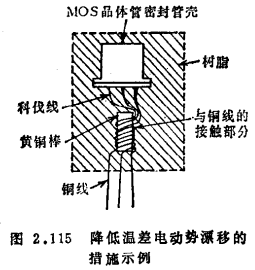Electronic Technology Forum
Examples of constant voltage drift of MOS transistor chopper and measures to reduce temperature difference
The constant voltage drift of the MOS transistor chopper is the thermoelectromotive force generated by the fluctuation of the room temperature and the fluctuation of the surrounding air. This thermoelectromotive force is mainly caused by the temperature difference between the leads of the MOS transistor and the contact point. The thermoelectromotive force between the Kovar wire and the copper wire, which is widely used as the lead of the transistor sealing tube seat, is about 27μV/℃.
For example, if there is a temperature difference of 0.1°C between the A/B points of the parallel chopper circuit shown in Figure 2.113, a thermoelectromotive force of 27μV will be generated. Constant voltage drift of MOS transistor chopper. This temperature difference is transmitted to the MOS transistor chip through the leads, and a temperature difference of about tens of thousands of degrees Celsius is generated between the source and drain electrodes. The thermoelectromotive force between the silicon substrate and aluminum, gold or copper is as high as about 400 μV/°C, so that for a slight temperature difference of about tens of ten thousandths of a degree Celsius, there is a corresponding thermoelectromotive force of about 0.01 μV.
Constant voltage drift of MOS transistor chopper
Figure 2.114 is an example of thermoelectromotive force measurement on this silicon substrate. In order to remove the influence of the Kovar wire, we tried to make a component with pure copper as the lead, and measured the temperature difference between the leads. Constant voltage drift of MOS transistor chopper. Compared with the thermoelectromotive force between the contact points of the Kovar wire, the thermoelectromotive force between the copper wires is completely negligible, so the measures to reduce the constant voltage drift are focused on reducing the thermoelectromotive force between the lead contact points. There are two measures:
1) Use copper as lead wire;
2) Reduce the temperature difference (temperature fluctuation) between the lead ends. Only Kovar wires are used in the sealed cases of commercially available semiconductor devices. If you want to change Kovar to copper, you should first solve the problems of cracks caused by the different coefficients of thermal expansion of the sealing glass and copper, and wire breakage caused by the oxidation of the copper surface.
In order to reduce the temperature difference, the leads should be cut as short as possible and close to each other before soldering. In addition, if the two lead wires are twisted together in an insulated manner, the isothermalization between the two lead wires and one resin wire can be realized.

As shown in Figure 2.115, the lead wire is replaced with a copper wire in the middle to make the contact part isothermal. Finally, the wired substrate should be installed in the package to prevent the internal air from being disturbed. Figure 2.116 shows the comparison of the effects of these measures.

Contact: Mr. Zou
Contact number: 0755-83888366-8022
Mobile phone: 18123972950
QQ: 2880195519
Contact Address: 5C1, Block CD, Tianji Building, Tianan Digital City, Chegongmiao, Futian District, Shenzhen
Please search WeChat official account: "KIA Semiconductor" or scan the following picture to "Follow" official WeChat official account
Please "follow" the official WeChat account: provide MOS tube technical assistance




